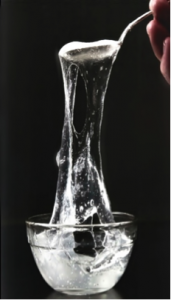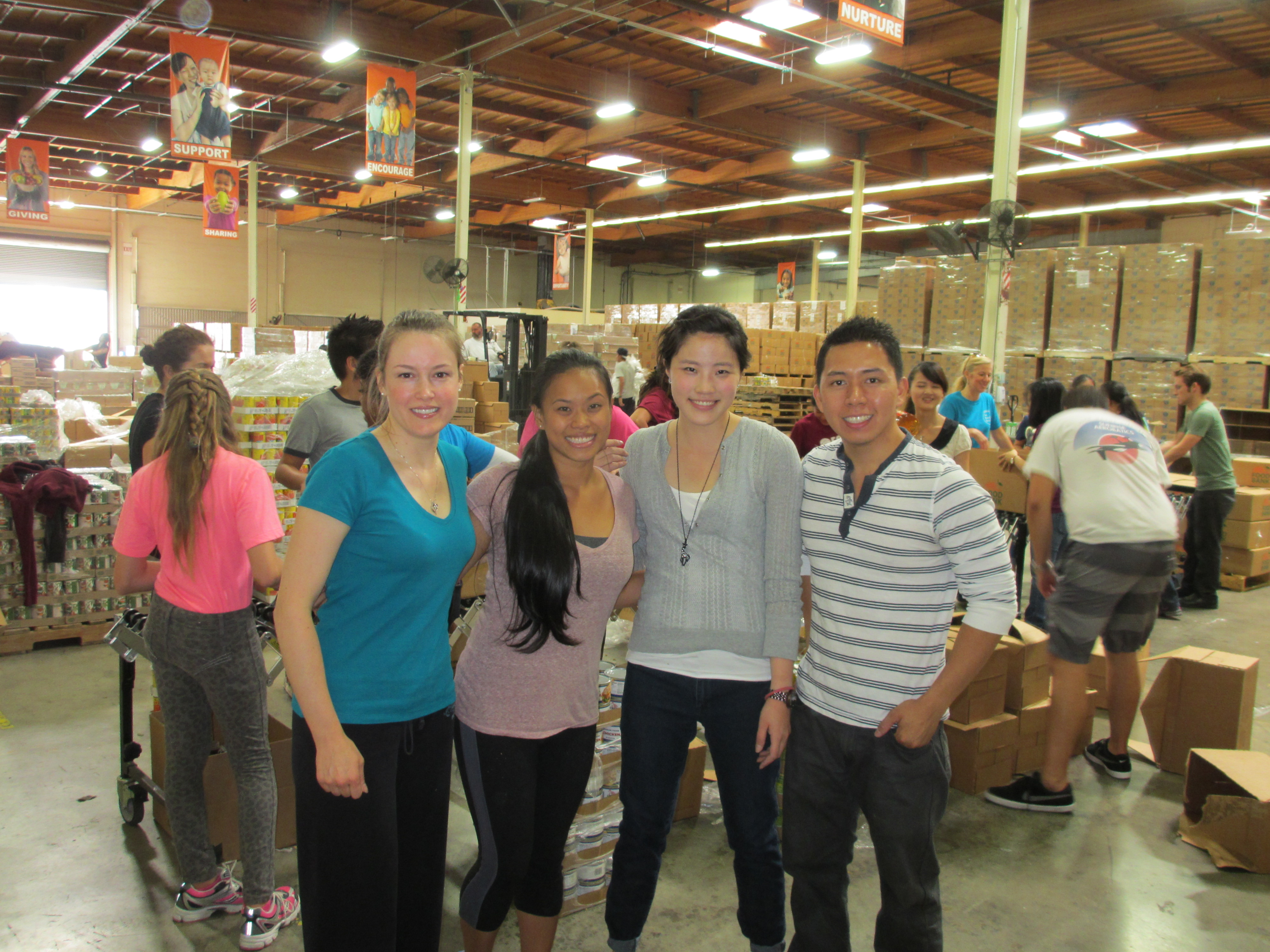By Diana Maricruz Perez Santos
When my friend Tom invited me to participate in this blog, he suggested I write about my research topic. I remember my answer: “24/7 is a lot gelatinized starch for me.” I have even earned the nickname “Diana Starch” between my peers. Every day I notice there is still much I must learn in this field. But, here I will write a little about this reaction and its use in the food industry.
 The science of gelatinization
The science of gelatinization
Starch gelatinization is the process where starch and water are subjected to heat causing the starch granules to swell. As a result, the water is gradually absorbed in an irreversible manner. This gives the system a viscous and transparent texture. The result of the reaction is a gel, which is used in sauces, puddings, creams and other food products, providing a pleasing texture.
The most common example to explain this phenomenon is pasta preparation: pasta is made mostly of semolina wheat (wheat flour) that contains high amounts of starch. When it is cooked in boiling water, the size increases because it absorbs water and it gets a soft texture.
From the kitchen to my thesis
The organic nature of starch is not predictable in food industry processes, resulting in slow progress in terms of technology development. Its use has led to the search for techniques to standardize behavior during industrial processes in order to optimize specific processes and provide solutions to common problems and give a guideline for the development of better products.
Currently, a large number of foods utilize starch gelatinization, and this governs the manner in which processes are designed. However it is known that this reaction is susceptible to many intrinsic and extrinsic factors that directly affect the way it develops, often a slight variation of any factors could sacrifice the characteristic texture of the food.
In order to continue enjoying soft food with great quality, progress in material analysis and characterization has enabled analytical techniques such as scanning electron microscopy, atomic force microscopy, and transmission electron microscopy for visual analysis of starch surface and morphology. Techniques such as x-ray diffraction and magnetic resonance imaging are useful to learn the specific structure of each type of starch, and others such as differential scanning calorimetry (the technique in which I specialize) serve to describe gelatinization according to their energy requirements.
This reaction also raised my interest in the study of process simulation techniques, where you can use special computer programs to model food production processes before they even exist.
Different varieties of starch and their functionality in various industrial processes are the biggest challenge to developing simple, easy, and comprehensive applications to predict the reaction behavior during production.
As you can see this is a little bit of the state of my research topic. If you are interested in learning more or have any questions regarding starch gelatinization or differential scanning calorimetry, leave them in the comment section below; it would be a pleasure to help you.
How do you use the amazing process of starch gelatinization? Research, work, or maybe simply cooking up a big bowl of pasta?
Want to keep up with the conversation? Follow us on Instagram and Facebook for quick updates on seminars, events, and food science!
Photo credit: Modernist Cuisine: The Art and Science of Cooking by http://modernistcuisine.com






I was wondering how I can see a glass transition in starch. The transition from glass to rubber for starch occurs before the gelatinization, right? I know how gelatinized starch looks like, but I cannot imagine what a “rubbery” or a “glassy” starch looks like. I tried adding small drops of water at a time to fairly dry starch (11% moisture w.b.). It started to clump up and get hard, which I assume is the “glass” state? Then as I added more water, it gelatinized, so I must have missed the “rubbery” state. I’m just trying the understand the difference between the “glass,” “rubbery,” and “gelatin” phases of starch from a visual and texture perspective.
Hi Annie, sorry for my very delay answer. To study the Tg using DSC is recommended to make several measurements on your starch with low moisture, varying the heating rate. This will help you see the transition with different resolutions. Knowing the ratios of amylose / amylopectin in the starch and the particle size are important to take in account when you interpreting the results.
Schematic diagrams of state and phase transitions of starch are very didactical. Maybe can help you to understand the differences between phases. You can find a good one in Starch: chemistry and technology book of BeMiller, J.N. and R.L. Whistler
I hope this information helps you. All the best for your research.
Hi Annie, sorry for my very delay answer. To study the Tg using DSC is recommended to make several measurements on your starch with low moisture, varying the heating rate. This will help you see the transition with different resolutions. Knowing the ratios of amylose / amylopectin in the starch and the particle size are important to take in account when you interpreting the results.
Schematic diagrams of state and phase transitions of starch are very didactical. Maybe can help you to understand the differences between phases. You can find a good one in Starch: chemistry and technology book of BeMiller, J.N. and R.L. Whistler
I hope this information helps you. All the best for your research.
Hi Diana Maricruz I want to know How do you make wheat flour to be clear gel
what process, equipment , and raw materials
please answer me , I find gel to massage in spa.
Regards, Thank you
Ongree (Thailand)
I struggle with Anemia & Starch Protiens cause a Histomine responce when My Platlets drop..I Know its the starch protien because I have the responce to tapioca & msg & they have a starch protien in common….in my exstensive resaerch to help my platelets stay up I found one tiny sentance that mentioned limiting gelitinized protiens Like Soy!….Using the Gelatinization concept I determined if I limited the foods that had a high gelatinizattion level my gut better absorbed the nutrients & my platelets came up….It was just a Hypothosis…But it worked! for the first time in 4 years I dont need a Blood transfusion!!!…..so I want to encourage you to continue your research! ….Litterally it could save lives.
Hi Diana, thank you for your article. My daughter has been diagnosed with Celiac Disease. I am finding it very challenging to find which flours, that do not contain gluten, will produce acceptable baked foodstuffs with a good crumb. From what I understand gelatinization of the starch in a flour will affect the crumb and possibly the moisture content of the product. Please do you have any suggestions? Everything I have read seems so “hit and miss”, and not at all technical or logical. Just a case of “make a mixture of different flours for the best result”, and no ratio’s or reasons why. I would be so grateful if you could help me. Thank you
we are into manufacturing of whole wheat flour which is stone ground and used to make flat bread. was studying the effect of starch damage, amylose amylopectin ratio, retrogradation of starch when it comes to softness of the end flat bread after 6-8 hours.
will more starch damage (24% instead of 16%) lead to softer flat bread?
what will help in retardation of retgrodation of starch when it comes to wheat variety, milling and by adding additives
Hi Diana,
Is that possible to keep the gelatinized starch solution in the freezer? Or can I freeze dry the suspension? Will this change the properties of starch suspension?
I am working on dog treats chew treats that need to be hard and tough. We pelletize the formula then injection mold the treats. The product gelatinizes in the injection molding barrel. Once the product is cooled and reground, will it melt/gelatinize again if subjected to the injection molding process again?
Respected Sir/Ma’am
Good evening
I want to know the relation between Starch gelatinization (onset, peak, conclusive and enthalpy) and their application at industrial level (with references).
I have a question concerning the Gelatinization of carbohydrates and what effect what it has on its sugars? When making a sauce one uses starch to thicken it. Flour is cooked for a long period of time
I was wondering what does this cooking do to the sugars from a dietary standpoint does it make them more complex or more simple?
How do I calculate the energy in joules required to gelatinize a certain starch?
thank you this helped us a lot
it really did didnt it luv <3